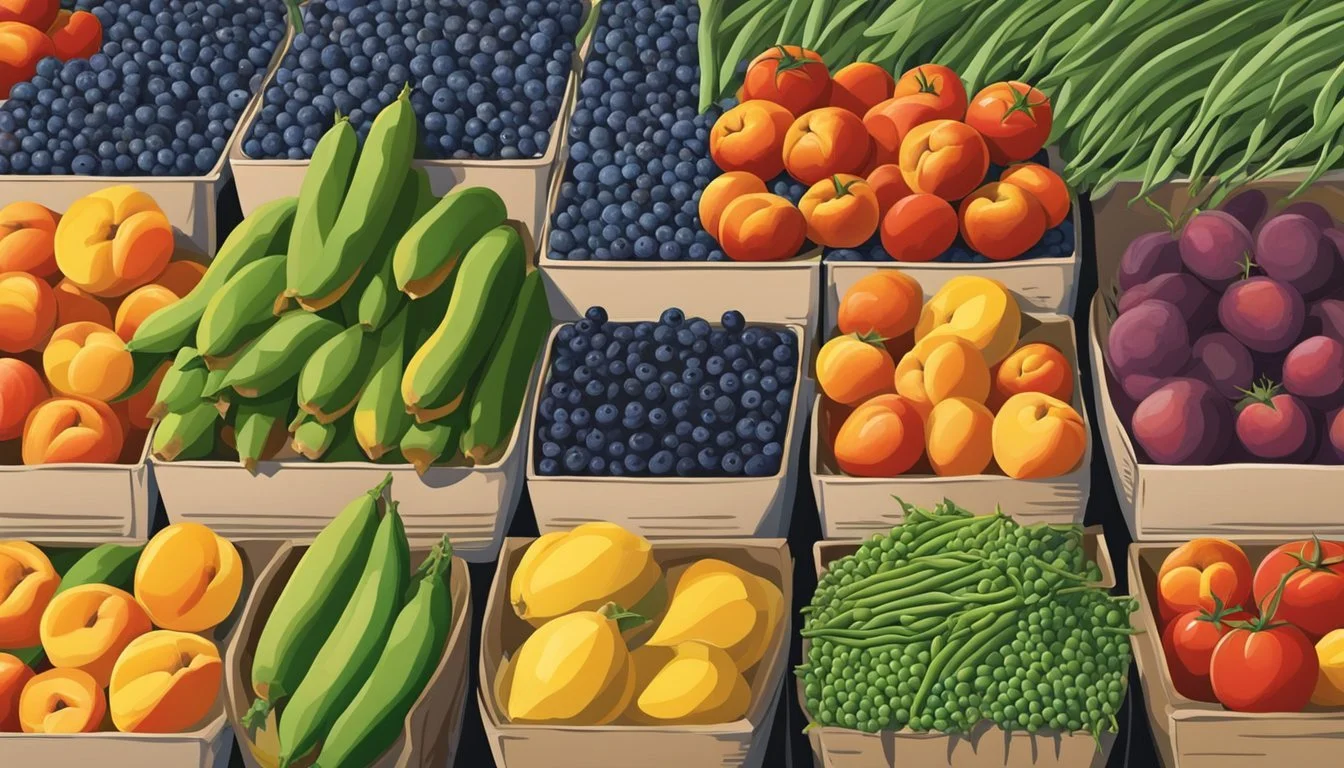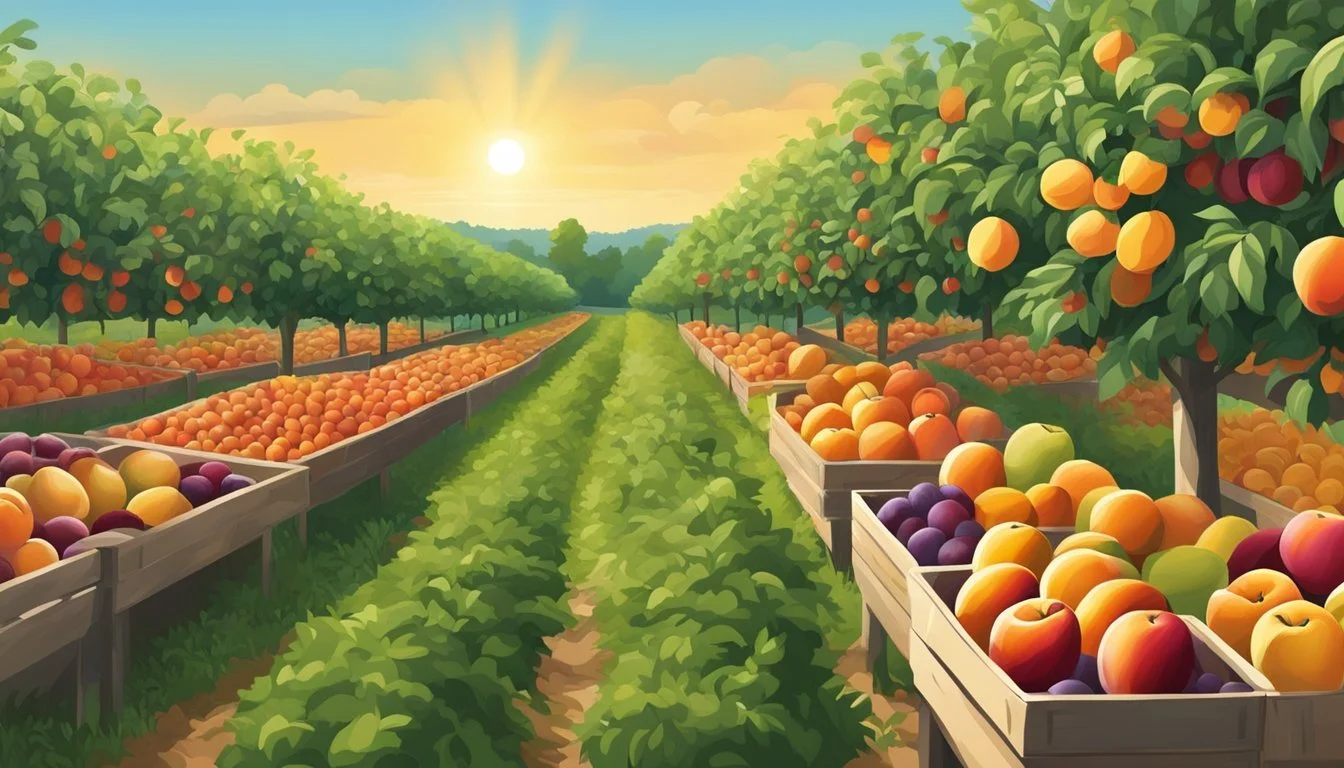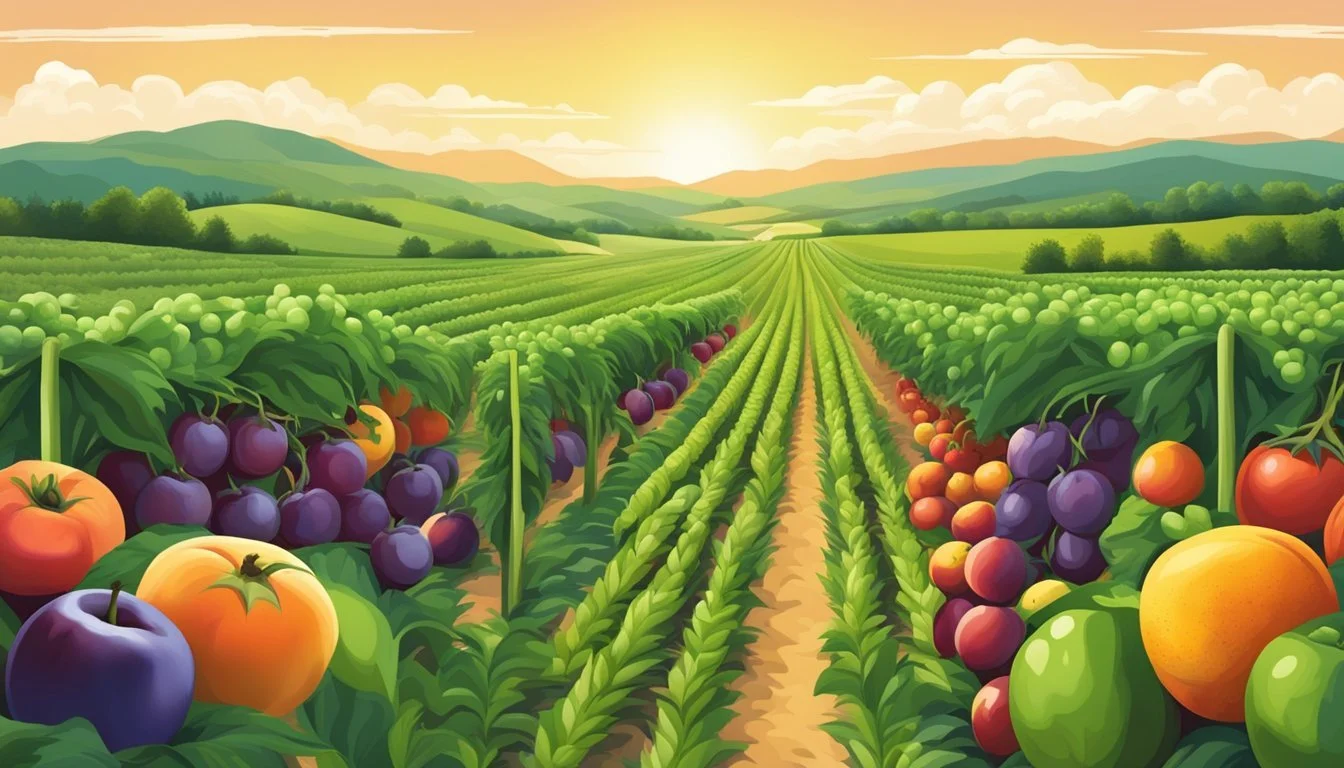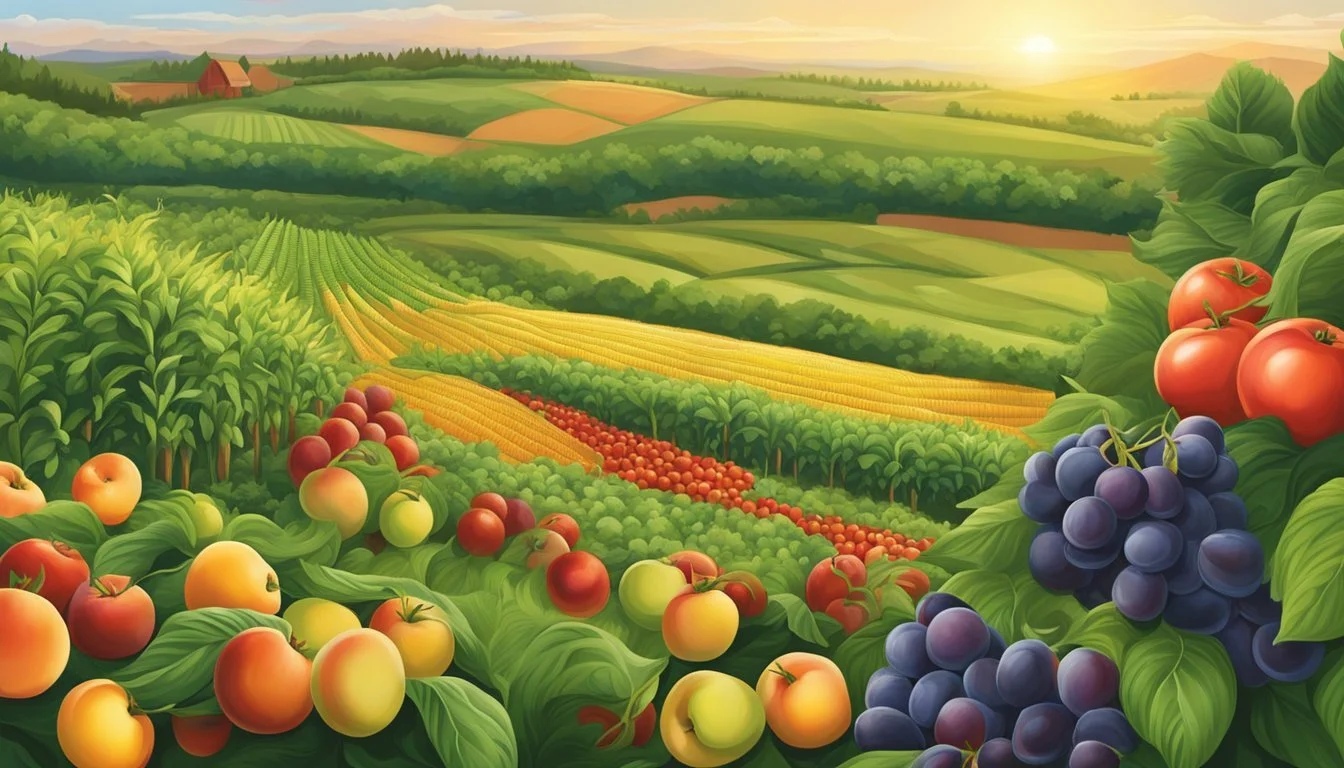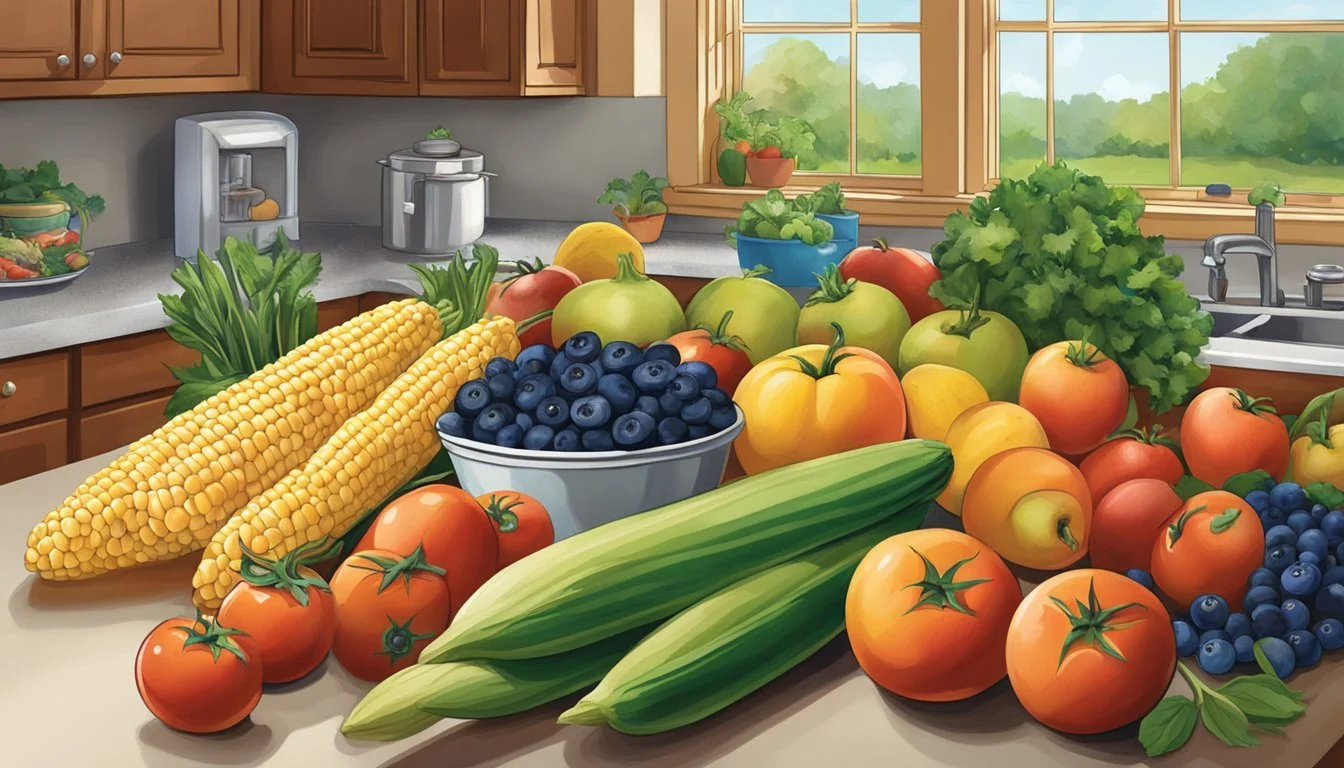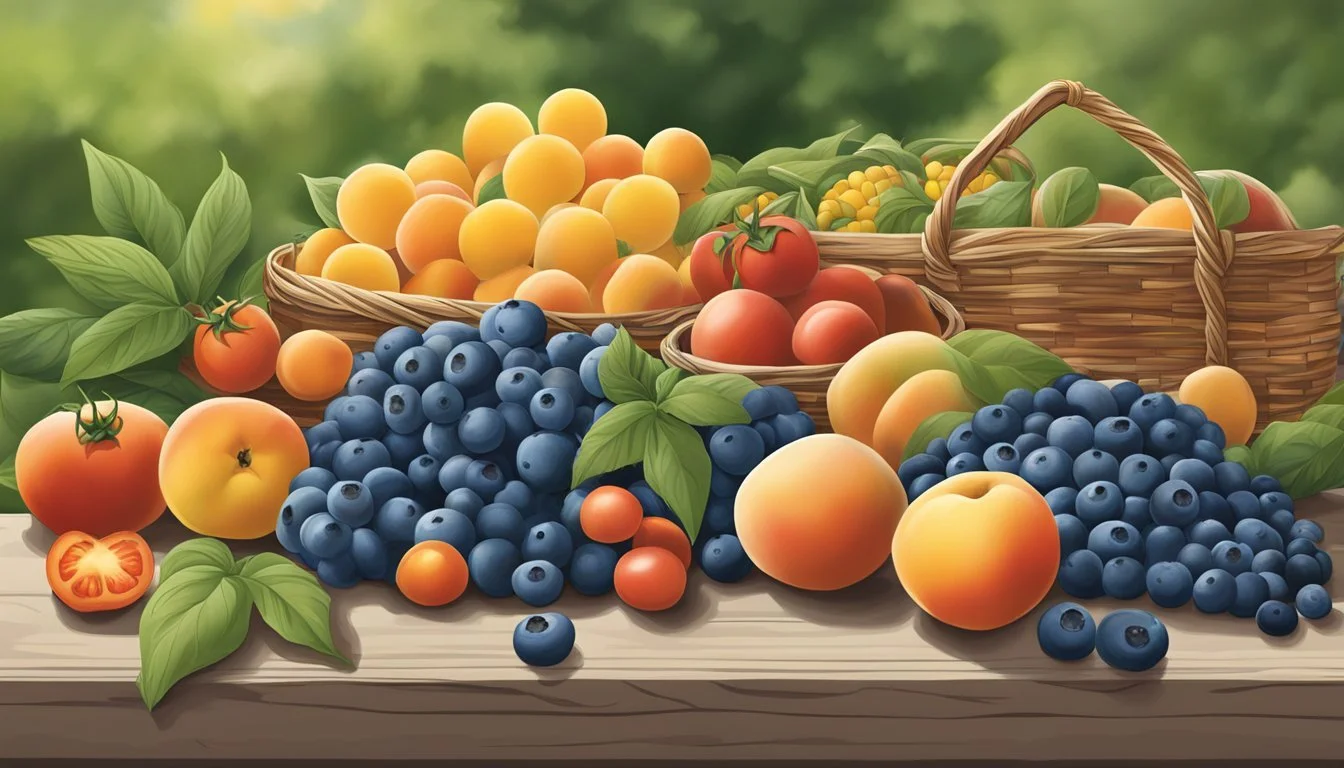Michigan Seasonal Fruit & Vegetables in August
Your Fresh Guide
This Article is Part of our Michigan Seasonal Fruit & Veg Calendar
August in Michigan heralds a season rich with a variety of fruits and vegetables at their peak of freshness. During this month, markets and farms across the state boast an abundance of produce, reflecting the summer's growing efforts. Consumers have the opportunity to indulge in the flavors of the region, with crops such as sweet corn (how long does corn last?), tomatoes, and watermelons readily available.
Michigan's climate and soil conditions in August create an optimal environment for a diverse harvest. Apples (how long do apples last?) begin to reach maturity, and Asian pears appear on branches, while fields yield the second growing season of crops like cabbage. The state's agricultural output is not limited to these; other vegetables such as beets and beans also arrive in abundance, providing ample choices for those seeking to incorporate fresh, seasonal ingredients into their diets.
This guide serves as a navigator through Michigan's August offerings, allowing consumers to confidently and clearly identify what is in season. By choosing local produce, individuals not only savor the taste of freshness but also support the localized economy and the state's farming community.
Overview of Michigan's August Produce
August marks a period of abundance in Michigan, with a variety of produce reaching peak ripeness. Shoppers can expect to find the freshest fruits and vegetables at local farmers markets, reflecting the state's rich agricultural landscape.
Key Fruits In Season
Apples: A diverse selection becomes available, ranging from sweet to tart.
Plums: Known for their juicy sweetness, perfect for eating fresh or in desserts.
Peaches: Fuzzy and juicy, ideal for pies and jams.
Blackberries: (how long do blackberries last?) Ripe for picking, these berries are excellent in preserves.
Michigan's August Fruit Checklist:
Apples
Plums
Peaches
Blackberries
Key Vegetables In Season
Sweet Corn: A summer staple, sweet and best enjoyed fresh.
Tomatoes: From cherry to beefsteak, they're at their ripest.
Cabbage: The second growing season begins, offering fresh leaves.
Peppers: Ranging from sweet bell to spicy varieties.
Michigan's August Vegetable Checklist:
Sweet Corn
Tomatoes
Cabbage
Peppers
Understanding Regional Variations
Variations in climate and soil across Michigan's regions result in differences in the exact timing of produce availability. While much of the state shares similar harvest times, the Upper Peninsula may experience slight delays due to cooler temperatures. Consumers are encouraged to connect with local farmers for the most current information on specific crops.
Seasonal Eating Benefits
When consumers choose local seasonal produce in August, they reap multiple benefits. These include amplified health attributes from peak freshness, reduced environmental impact due to lower transportation needs, and support for Michigan's local economy through direct patronage of regional growers.
Health Advantages
Consuming fruits and vegetables during their natural August ripening period in Michigan leads to higher nutrient intake. At this stage, produce such as apples, watermelons, and sweet corn is at its peak in flavor and nutritional value. Freshness is paramount since the time from harvest to table is shorter, ensuring that vitamins, minerals, and antioxidants are at their optimal levels.
Environmental Impact
Local produce in Michigan supports a reduced carbon footprint. Food that is grown and consumed within the same region demands less transportation, which subsequently lowers greenhouse gas emissions. Seasonal eating also often involves less packaging and processing, contributing further to environmental conservation efforts.
Economic Benefits
Choosing to eat seasonally also bolsters Michigan’s economy. Buying from local farmers markets and community-supported agriculture (CSA) programs:
Supports local farmers directly by increasing their sales.
Keeps money circulating within the community.
Creates jobs and supports the agricultural infrastructure.
Fostering a robust market for Michigan produce can also encourage the preservation of local farmland and traditional farming practices.
August Harvest Calendar for Michigan
In Michigan, the month of August is a bountiful period for a variety of fruits and vegetables. The state's rich soil and favorable growing conditions contribute to the production of delicious and nutritious produce. Below is a guide to what consumers can typically find in season during this month.
Fruits
Peaches: These juicy stone fruits are at their peak, perfect for pies or enjoyed fresh.
Nectarines: Similar to peaches, nectarines are ripe for picking, offering a slightly firmer texture.
Plums: With a diverse range, plums provide a sweet and tart flavor profile.
Raspberries: These delicate berries are still available, ideally harvested in the cool morning.
Vegetables
Cucumbers: (how long do cucumbers last?) Crisp and refreshing, cucumbers are winding down but still available early in the month.
Eggplant (What wine goes well with eggplant?): These versatile vegetables are abundant, ideal for grilling or as a meat substitute in dishes.
Peppers: From sweet to spicy, peppers add a burst of flavor to any meal.
Tomatoes: Field-ripened tomatoes are in their prime, with varieties ranging from cherry to beefsteak.
Sweet Corn: A summer staple, sweet corn is enjoyed on the cob or as an addition to salads and salsas.
In summary, August is a thriving month for agricultural output in Michigan. Consumers have the opportunity to enjoy fresh, locally-grown produce that supports the state's farming community. The flavors of the produce harvested in this season are at their best, reflecting the care and dedication of Michigan's farmers.
Where to Find Seasonal Produce
In August, Michigan's seasonal produce is at its peak, offering a variety of fruits and vegetables. Consumers can access these fresh items from several sources, ensuring they are enjoying the local bounty at its best.
Farmers Markets and Farms
Farmers Markets: They are a hub for fresh, locally-sourced fruits and vegetables. Patrons will find an abundance of in-season produce like tomatoes, sweet corn, and a variety of berries at these community gatherings. Farm Locations: Visiting local farms can be a direct way to purchase fresh produce. Farms often offer pick-your-own options or pre-picked selections, especially for August favorites such as peaches, plums, and nectarines.
Community Supported Agriculture (CSA)
CSA Programs: Participants in a CSA receive a regular share of the harvest throughout the farming season. This could include a wide range of August produce, including peppers, eggplant (What wine goes well with eggplant?), and greens. It fosters a direct partnership between local farmers and community members, often providing exclusive access to harvest events and farm news.
Grocery Stores and Online Resources
Grocery Stores: Many grocery stores support local farms by stocking Michigan fruits and vegetables during their peak seasons. Shoppers can look for signage indicating local produce or ask store associates for assistance. Online Resources: Websites and online platforms can connect consumers to local CSA programs, farms, and markets. These resources make it easier to find specific in-season produce like cucumbers, apples, and melons.
Preserving Michigan's Seasonal Produce
August heralds a bountiful harvest in Michigan, offering a medley of fruits and vegetables ripe for preservation. Here are practical methods for extending the life of August's produce.
Canning and Freezing Tips
Canning is ideal for many of Michigan's summer fruits and tomatoes, which can be later used in sauces, jams, and salsas. To ensure safety and quality, one should use pressure canning for vegetables, particularly for greens, to prevent botulism. Freezing provides a simpler alternative, maintaining taste and nutritional value, especially for berries, sweet corn, and snap beans. Blanching vegetables before freezing can help preserve flavor and texture.
Fruit Canning: Use a water bath for high-acidic fruits.
Vegetable Canning: Employ pressure canning for safety.
Freezing: Blanch, cool, and freeze on trays before bagging.
Drying and Fermentation
Drying extends the shelf life of herbs, and sliced fruits and vegetables by removing moisture that bacteria, yeasts, and molds need to grow. One can use a dehydrator or a low-temperature oven for this process. Fermentation, on the other hand, not only preserves but also enhances the nutritional value of foods like cucumbers and cabbages, turning them into pickles and sauerkraut (how long does sauerkraut last?).
Herbs: Air-dry or use a dehydrator.
Fruits & Vegetables: Slice thinly for uniform drying.
Fermentation: Use proper salt concentrations for successful fermentation.
Storage Crops
Certain crops harvested in August can be stored as-is for several months. Root vegetables like potatoes and carrots, as well as onions and winter squash, should be kept in cool, dark, and well-ventilated areas. Apples, another storage-friendly crop, benefit from refrigeration or a cool cellar.
Root Vegetables: Store in a cool, humid environment.
Onions & Winter Squash: Keep dry and well-ventilated.
Apples: Refrigerate or place in a cool cellar.
Cooking and Recipe Ideas
August in Michigan brims with an abundance of fresh produce that can inspire a host of cooking endeavors and recipe creations. The season's offerings allow for a delightful exploration of taste and texture, particularly with fruits and vegetables like tomatoes, sweet corn, and stone fruits.
Tomatoes are a versatile fruit and can be the star of a dish or an accompaniment. They bring brightness and acidity to salads, can be slow-roasted to concentrate their sweetness, or turned into a rich and flavorful sauce for pasta dishes.
Sweet Corn bursts with the taste of summer and is excellent when cooked simply. One can grill it to bring out a smoky flavor or slice the kernels off for a fresh addition to salsas. For a comforting side, chefs may consider making corn pudding or a creamy corn chowder.
When it comes to Stone Fruits, such as peaches, nectarines, and plums, their succulent sweetness lends itself to a myriad of desserts. Cobblers, crisps, and pies are classic preparations, but these fruits can also accompany savory dishes such as grilled pork or a cheese platter.
Fresh Herbs Culinary Uses Basil Pesto, tomato dishes, fresh salads Cilantro Salsas, Mexican cuisine, marinades Parsley Garnishes, Middle-Eastern tabbouleh
Utilizing these herbs can elevate the flavors of any dish, providing freshness and complexity. A confident chef might experiment by incorporating them into dressings, sauces, or infused oils to complement the peak-season produce.
Michigan's August bounty also encourages preservation methods for future enjoyment. One can create pickles, jams, or canned tomatoes to capture the essence of summer for the colder months. Thus, the culinary possibilities are as rich and abundant as the harvest itself.
Michigan's Supportive Food Systems
Michigan's food systems are bolstered by active and research-focused stakeholders that enhance the vibrancy and sustainability of local agriculture and food supply. The Center for Regional Food Systems and local food movements are integral parts of this network.
Role of the Center for Regional Food Systems
The Center for Regional Food Systems at Michigan State University is dedicated to improving Michigan’s food system. It collaborates with farmers, local agencies, and businesses to create a robust system that supports sustainable agriculture. Their strategies include research, developing policies, and fostering partnerships that enhance the local food ecosystem. The Center’s initiatives contribute to ensuring that fresh produce is available throughout the state, supporting Michigan's abundant August harvest.
Local Food Movements
Local food movements in Michigan mobilize community efforts to connect consumers with locally sourced foods. They emphasize building relationships between consumers and farmers to sustain local economies. Farmers' markets, community-supported agriculture (CSA), and urban agriculture projects are examples of these movements in action. They are instrumental in championing seasonally available foods, such as those plentiful in August, while fostering a shared value system around local, sustainable food production and consumption.
Conclusion
In Michigan, August is a prime month for reaping the benefits of seasonal eating. With an abundance of local produce, consumers can indulge in the freshness of fruits and vegetables at the peak of their ripeness. Markets brim with vibrant selections, offering nutritional variety and supporting regional farming communities.
During this month, shoppers can find a plethora of fresh picks:
Fruits:
Apples
Watermelon
Blueberries
Peaches
Plums
Nectarines
Vegetables:
Corn
Tomatoes
Cucumbers
Eggplant
Summer squash
Green beans
Embracing local Michigan harvests not only bolsters the economy but also ensures peak flavor and nutrition. By choosing locally-sourced food, consumers help to reduce the carbon footprint associated with long-distance transportation.
In short, August yields a diverse and bountiful selection of fresh Michigan produce, making it an ideal time for residents and visitors alike to support local farmers and enjoy the fruits of their labor.

